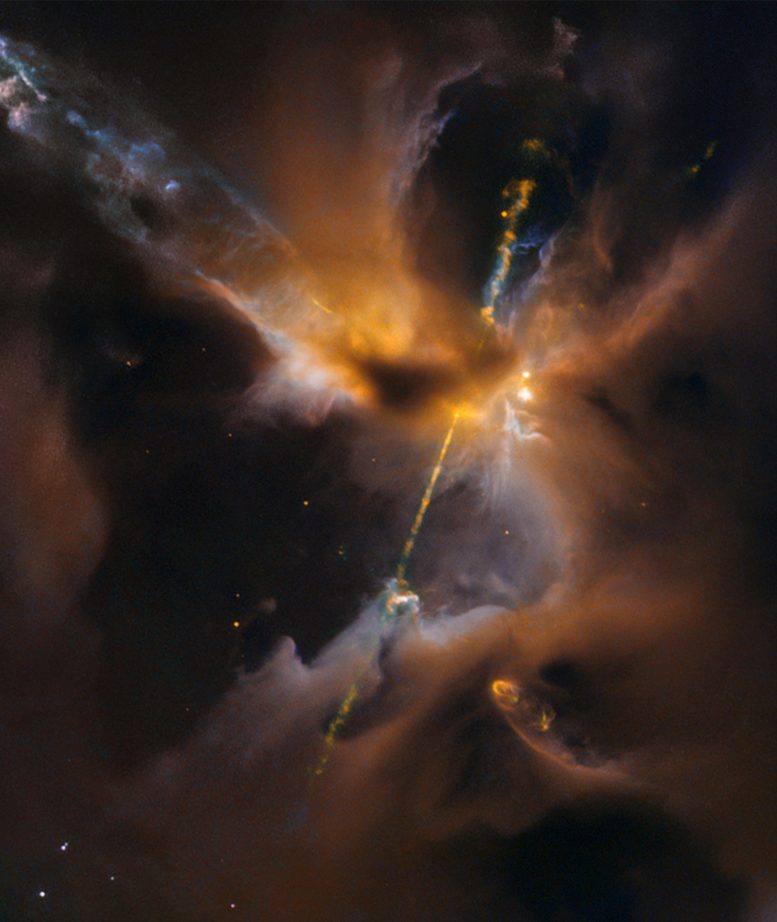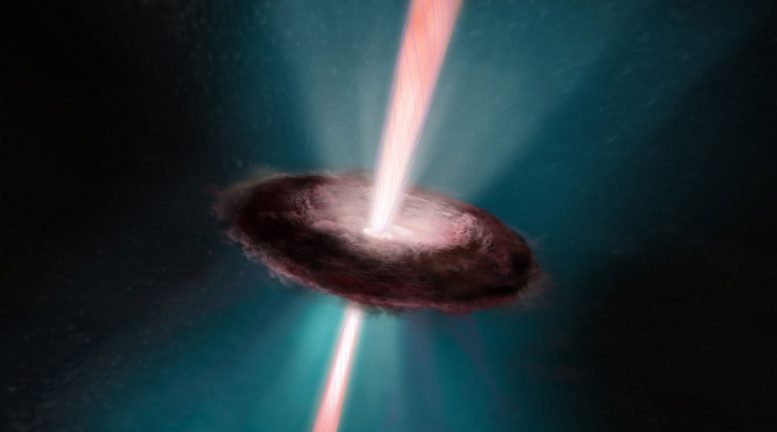
This celestial lightsaber does not lie in a galaxy far, far away, but rather inside our home galaxy, the Milky Way. It’s inside a turbulent birthing ground for new stars known as the Orion B molecular cloud complex, located 1,350 light-years away. Credit: NASA/ESA
NASA’s Hubble Space Telescope views a newborn star shooting twin jets out into space as a sort of birth announcement to the universe.
Just in time for the release of the movie “Star Wars Episode VII: The Force Awakens,” NASA’s Hubble Space Telescope has photographed what looks like a cosmic, double-bladed lightsaber.
“Science fiction has been an inspiration to generations of scientists and engineers, and the film series Star Wars is no exception,” said John Grunsfeld, astronaut and associate administrator for the NASA Science Mission directorate. “There is no stronger case for the motivational power of real science than the discoveries that come from the Hubble Space Telescope as it unravels the mysteries of the universe.”
This celestial lightsaber does not lie in a galaxy far, far away, but rather inside our home galaxy, the Milky Way. It’s inside a turbulent birthing ground for new stars known as the Orion B molecular cloud complex, located 1,350 light-years away.
This sequence combines a two-dimensional zoom and a three-dimensional flight to explore the Hubble Space Telescope’s striking image of the Herbig-Haro object known as HH 24. Credit: NASA, ESA, and F. Summers, G. Bacon, Z. Levay, and L. Frattare (Viz 3D Team, STScI)
When stars form within giant clouds of cool molecular hydrogen, some of the surrounding material collapses under gravity to form a rotating, flattened disk encircling the newborn star.
Though planets will later congeal in the disk, at this early stage the protostar is feeding on the disk with a Jabba-like appetite. Gas from the disk rains down onto the protostar and engorges it. Superheated material spills away and is shot outward from the star in opposite directions along an uncluttered escape route — the star’s rotation axis.
Shock fronts develop along the jets and heat the surrounding gas to thousands of degrees Fahrenheit. The jets collide with the surrounding gas and dust and clear vast spaces, like a stream of water plowing into a hill of sand. The shock fronts form tangled, knotted clumps of nebulosity and are collectively known as Herbig-Haro (HH) objects. The prominent HH object shown in this image is HH 24.
Just to the right of the cloaked star, a couple of bright points are young stars peeking through and showing off their own faint lightsabers — including one that has bored a tunnel through the cloud towards the upper-right side of the picture.

This is an artist’s concept of the fireworks that accompany the birth of a star. The young stellar object is encircled by a pancake-shaped disk of dust and gas left over from the collapse of the nebula that formed the star. Gas falls onto the newly forming star and is heated to the point that some of it escapes along the star’s spin axis. Intertwined by magnetic fields, the bipolar jets blast into space at over 100,000 miles (160,000 kilometers) per hour. As seen from far away, they resemble a double-bladed lightsaber from the Star Wars film series. Credit: NASA, ESA, and A. Feild (STScI)
Overall, just a handful of HH jets have been spotted in this region in visible light, and about the same number in the infrared. Hubble’s observations for this image were performed in infrared light, which enabled the telescope to peer through the gas and dust cocooning the newly forming stars and capture a clear view of the HH objects.
These young stellar jets are ideal targets for NASA’s upcoming James Webb Space Telescope, which will have even greater infrared wavelength vision to see deeper into the dust surrounding newly forming stars.









earth too may have one of these energy spews and much alike an fresh water clam and or muscle life form uses such as jet propulsion and the world size version having the thrust ability of an atmospheric meteorite would be able to be at least six times beyond the speed of sound quickly and with the radio active bacteria and heavy split atoms scattered about in chernobyl and japan the air borne off spring will assist the metamorphic process along with an invisible version yet it alike the space shuttles propulsion can be shut down in an emergency situation in the near future by draining it of its energy and or its fuel supply and or its electrical energy supply to help chernobyl with such will require an micro biology specialist to control their over population and clean up of its made heavy split atoms via an very cautious process they and earth science specialist should be very good at.